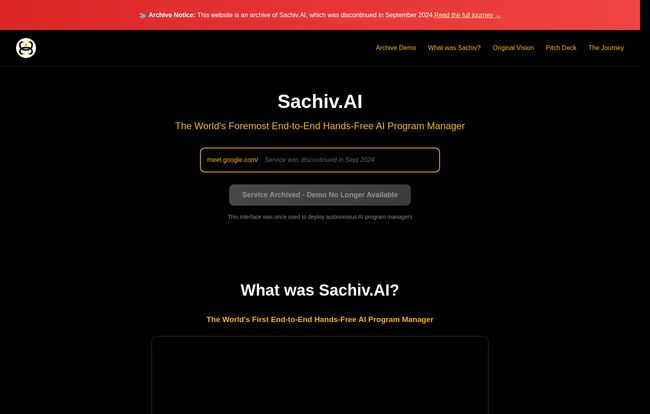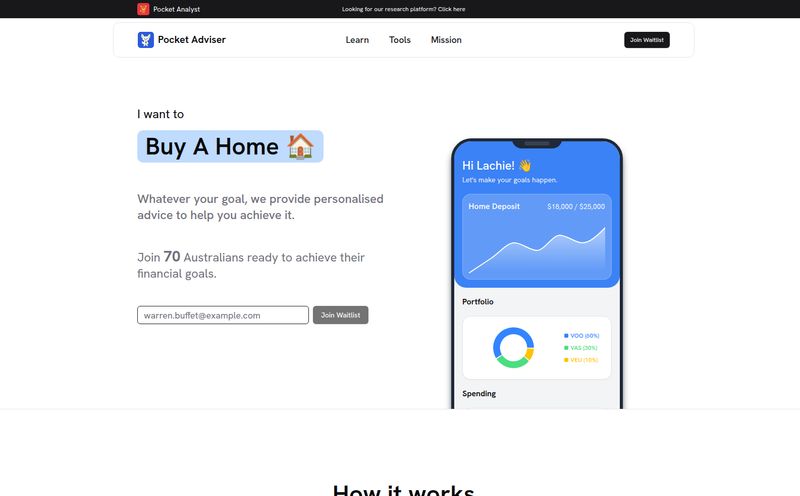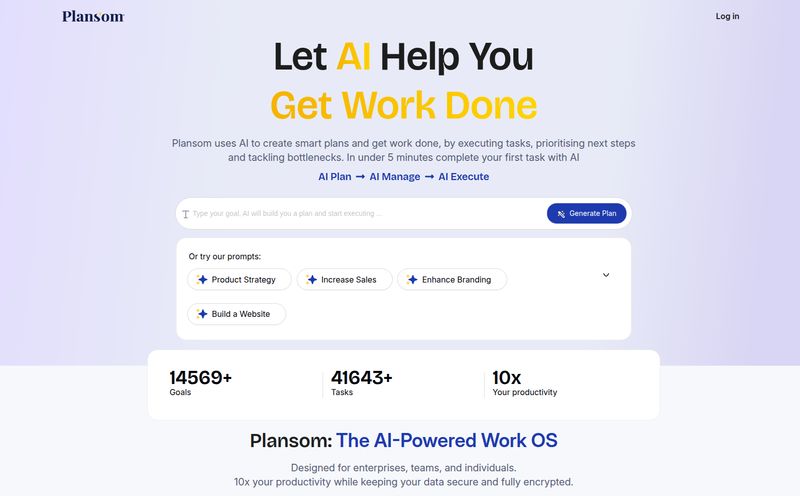I feel like every week there's a new AI tool that promises to change my life. Seriously. It's a gold rush out there, and every developer is trying to build the next big thing that will finally, finally organize our chaotic work lives. We've all seen them: AI note-takers, AI calendar assistants, AI email writers. But every so often, a tool comes along that aims for something bigger. Something more... holistic.
That was Sachiv.ai. And I use the word “was” intentionally.
If you head over to their site now, you’ll be greeted by an archive notice. Sachiv.ai was officially discontinued in September 2023. But instead of just shrugging and moving on to the next shiny object, I think it's worth taking a moment to look at what they were trying to build. Because their vision tells us a lot about where AI in the workplace is headed, even if they didn't quite make it to the destination.
So, What Was Sachiv.AI Supposed to Be?
In a nutshell, Sachiv.ai wanted to be your team's AI program manager. Not just an assistant, but a fully-fledged member of the team. Think of it as an AI secretary with a promotion. Its job wasn't just to sit in on your Zoom or Teams meetings and spit out a transcript. Oh no. The vision was so much grander than that.
The whole idea was to create a single source of truth for all your projects. An AI that could:
- Attend meetings and actually understand the context.
- Automatically create tickets in JIRA, tasks in Asana, or cards on Monday.com based on action items discussed.
- Schedule follow-up meetings in your Google Calendar.
- Track project progress and even flag potential risks before a human project manager even had their morning coffee.
It was designed to be the connective tissue between conversation and action, a problem we all face. How many times has a brilliant idea or a critical task been lost in the ether of a 45-minute call? Sachiv.ai promised to catch it, tag it, and put it right where it belonged. That’s the dream, right?

Visit Sachiv.AI
More Than Just Meeting Notes
This is where Sachiv.ai really tried to differentiate itself from a crowded market. You’ve got a ton of great meeting transcription tools out there. I've used many of them—Otter.ai, Fireflies.ai, Fathom. They’re fantastic for creating a record of what was said. Some even do a decent job of pulling out highlights and action items.
But they are fundamentally passive. They record. They report. They summarize.
Sachiv.ai wanted to be proactive. It was built on the idea of “hands-free automation.” It wasn't just about knowing that Dave promised to get the TPS reports done by Friday; it was about automatically creating the task for Dave, assigning it to him in the project management tool, and maybe even sending him a gentle nudge on Thursday. It aimed to close the loop, turning discussion into documented, trackable work without a human having to lift a finger. A pretty bold ambition, if you ask me.
The Ambitious Features on Offer
When you look at the feature list, you can see the scale of what they were building. It went far beyond multilingual transcription. We're talking about a system that claimed to understand dependencies between tasks and provide company-wide insights into project velocity. The goal was to build a “collective intelligence,” merging the nuances of human conversation with the cold, hard logic of machine processing.
The promise was tantalizing. Imagine an AI that could tell you, “Hey, the design team’s feedback on the mockups is delayed, which is going to push back the development timeline by three days.” That’s a level of intelligence that moves past simple automation and into genuine operational partnership. It’s the kind of thing that could genuinely reduce the mental load on team leads and managers, freeing them up for more strategic thinking instead of constant cat-herding.
The Price of a Revolution (And Other Hurdles)
Of course, this kind of futuristic AI teammate wasn’t going to be free. The pricing structure tells a story in itself, showing a clear path from small teams to massive enterprises. It was ambitious, just like the tech.
| Plan | Monthly Price | Key Features |
|---|---|---|
| Spark | $29.99 | 20 meeting hours, transcripts, key moments. |
| Flame | $99.99 | 75 meeting hours, plus custom post-meeting intelligence. |
| Fire | $499 | 400 meeting hours, plus custom APIs and integrations. |
| Blaze | Starts at $3,000 | 2500 hours, 99.99% SLA, on-premise options. |
While the entry-level “Spark” plan was reasonably priced for a small team or freelancer, the cost escalated quickly. The “Blaze” plan, starting at $3k a month, was clearly aimed at large corporations. This might have been one of the hurdles. It’s one thing to pay for a transcription service; it’s another to budget for a full-blown AI program manager, especially when the technology is still nascent. You're not just buying a tool; you're buying into a whole new way of working, and that can be a tough sell.
And let's be honest, the reliance on AI is a double-edged sword. For it to work, the AI has to be incredibly good. If it misinterprets a key deadline or assigns a task to the wrong person, it creates more work, not less. The effectiveness is entirely dependent on the quality of the AI's training, and that is a monumentally difficult thing to perfect.
So, What Happened to Sachiv.AI? A Post-Mortem
This is the big question, isn't it? The website doesn't give a reason, only that it was discontinued. As someone who watches this space closely, I have a few theories.
My gut tells me it was a classic case of being too early. The vision was incredible, but the technology to execute it flawlessly across countless different team workflows and communication styles might not have been quite there yet. Getting an AI to understand the subtle sarcasm, inside jokes, and unspoken context of a team meeting is the holy grail of conversational AI. It’s one thing to transcribe words; it’s another thing entirely to comprehend intent.
It's also possible the market wasn't ready. While the idea sounds great, it requires a significant amount of trust and a willingness to integrate a powerful AI deep into your core operations. Many companies are still just getting comfortable with basic automation. Jumping straight to a full AI program manager might have been too big a leap.
Or maybe it was just a tough, crowded market. Even if you're different, you're still competing for the same budget dollars as dozens of other productivity tools. Sometimes, a simpler, more focused solution (like the transcription-focused competitors) is an easier sell, even if it’s less powerful.
The Legacy of a Pioneer
I don’t see Sachiv.ai as a failure. I see it as a pioneer. It was a bold attempt to solve a huge problem, and it pushed the conversation forward. The ideas that Sachiv.ai championed—proactive AI, hands-free automation, and a single source of project truth—are not going away. In fact, we’re seeing them pop up in more mainstream tools.
Projects like this are stepping stones. They show us what’s possible, even if they stumble along the way. The dream of an AI teammate that truly lightens our load is still very much alive. Someone will eventually crack it, and when they do, they’ll be standing on the shoulders of ambitious projects like Sachiv.ai.
Frequently Asked Questions
What exactly was Sachiv.ai?
Sachiv.ai was an AI-powered program and project manager. It was designed to attend online meetings, understand discussions, and then automatically create tasks in project management tools like JIRA or Asana, schedule follow-ups, and track project progress.
Is Sachiv.ai still available to use?
No, Sachiv.ai was discontinued in September 2023. Its website now exists as an archive of the project's vision and features.
How was Sachiv.ai different from tools like Otter.ai?
While tools like Otter.ai or Fireflies.ai primarily focus on transcribing meetings and summarizing them, Sachiv.ai aimed to be more proactive. It was built to take action based on the meeting content, such as creating and assigning tasks directly in other software, making it more of an active project manager than a passive note-taker.
What tools could Sachiv.ai integrate with?
It was designed to integrate with a suite of popular workplace tools, including Zoom, Google Meet, and Microsoft Teams for meetings, and JIRA, Asana, and Monday.com for project management, as well as Google Calendar for scheduling.
What did Sachiv.ai cost?
Pricing ranged from a $29.99/month “Spark” plan for individuals or small teams to an enterprise-level “Blaze” plan that started at $3,000/month, with tiers in between. The cost was primarily based on the number of included meeting hours per month.
Conclusion
It’s always a little sad to see an innovative project shut down. Sachiv.ai was a glimpse into a future where our digital tools are less like tools and more like teammates. It tackled a real, thorny problem: the gap between talking about work and actually doing it. While its journey has ended, the path it forged is one that others will surely follow. The quest for the perfect AI project manager continues, and for that, we have pioneers like Sachiv.ai to thank.
Reference and Sources
- Sachiv.ai Archive - The archived official website.
- Otter.ai - A popular AI meeting transcription service.
- Fireflies.ai - Another competitor in the AI meeting assistant space.



